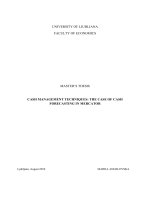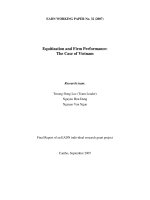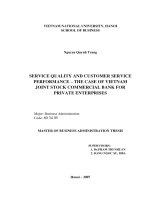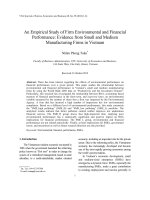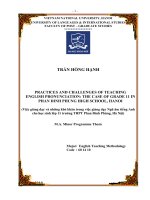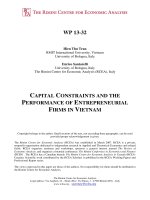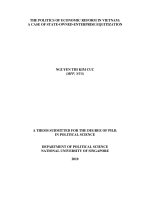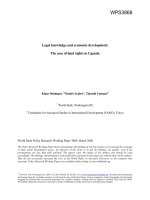Do better institutions boost firm performance the case of manufacturing firms in vietnam
Bạn đang xem bản rút gọn của tài liệu. Xem và tải ngay bản đầy đủ của tài liệu tại đây (2.25 MB, 85 trang )
UNIVERSITY OF ECONOMICS
HO CHIMINHCITY
VIETNAMTHE NETHERLANDS
INSTITUTE OF SOCIAL STUDIES
THE HAGUE
VIETNAM - NETHERLANDS
PROGRAMME FOR M.A IN DEVELOPMENT ECONOMICS
DO BETTER INSTITUTIONS BOOST FIRM PERFROMANCE?
THE CASE OF MANUFACTURING FIRMS IN VIETNAM
BY
NGUYEN THI NHA TRANG
MASTER OF ARTS IN DEVELOPMENT ECONOMICS
HO CHI MINH CITY, NOVEMBER 2015
UNIVERSITY OF ECONOMICS
HO CHIMINHCITY
VIETNAMTHE NETHERLANDS
INSTITUTE OF SOCIAL STUDIES
THE HAGUE
VIETNAM - NETHERLANDS
PROGRAMME FOR M.A IN DEVELOPMENT ECONOMICS
DO BETTER INSTITUTIONS BOOST FIRM PERFROMANCE?
THE CASE OF MANUFACTURING FIRMS IN VIETNAM
A thesis submitted in partial fulfilment of the requirements for the degree of
MASTER OF ARTS IN DEVELOPMENT ECONOMICS
By
NGUYEN THI NHA TRANG
Academic Supervisor:
Prof. Dr. NGUYEN TRONG HOAI
HO CHI MINH CITY, NOVEMBER 2015
DECLARATION
“This is to certify that this thesis entitled “Do better institutions boost firm
performance? The case of manufacturing firms in Vietnam”, which is submitted by me
in fulfillment of the requirements for the degree of Master of Arts in Development
Economics to the Vietnam – The Netherlands Program (VNP).
The thesis constitutes only my original work and due supervision and
acknowledgement have been made in the text to all materials used.”
Nguyen Thi Nha Trang
ACKNOWLEDGMENTS
Writing a thesis is like taking a long journey, which requires a lot of time and
effort. During this journey, sometimes we feel lost, exhausted and want to give up, and
to get to the destination we truly need guidance, cheers, encouragement and motivation
from instructors, families, friends, and even passers-by. Looking back at this journey, I
would like to extend my heartfelt appreciation to many people who have wholeheartedly
cheered me on and guided me through.
First and foremost, I would like to express my deepest gratitude to my
supervisor, Professor Nguyen Trong Hoai, who was always available to answer any
questions of mine and helped me stay focused on the research. Extremely busy, he never
failed to answer my calls or send me a text back. His knowledge, patience and
encouragement were the emotional and intellectual fuel that I needed to stand up and
step forward whenever I felt discouraged and wanted to stop halfway.
I would also like to extend my most sincere thanks to Dr. Tran Tien Khai, Dr.
Pham Khanh Nam, Dr. Pham Hoang Van, and Dr. Truong Dang Thuy for their valuable
suggestions and comments on my TRD, which kept me from straying away from “the
main road”. Without their support, I could never reach the finish line of this journey. My
special thanks also go to all the VNP teachers and support staff. Not only did they assist
me with my study and thesis drafting process, they also made me truly feel to be a part
of this wonderful community, to relive a beautiful and unforgettable college life.
I wish to thank, from the bottom of my heart, my wonderful classmates:
Khanh Vu, for guiding me through the complicated Vietnam Enterprise Survey and Stata
techniques, friends from my mini-group: Thien, Nhung, Hung, Ly, Viet for constantly
reminding me of not giving up so that we can proudly celebrate together as VNPers, and
other classmates for co-building a warm and bright C19 family. Finally, I thank you my
family, my husband and my little son for their unconditional love and support. I always
hope I can make them proud.
ABBREVIATIONS
ADB
: The Asian Development Bank
AEC
: The ASEAN Economic Community
ASEAN-6
: Brunei, Indonesia, Malaysia,
the Philippines, Singapore, Thailand
ASEAN-4
: Malaysia, the Philippines, Singapore, Thailand
BTA
: The U.S.-Vietnam Bilateral Trade Agreement
GDP
: Gross domestic production
GSO
: General statistics office of Vietnam
GVN
: Government of Vietnam
OECD
: Organization for Economic Cooperation and Development
PCI
: Provincial Competitiveness Index
ROA
: Return on Assets
ROE
: Return on Equity
SMEs
: Small and medium enterprises
SOEs
: State-owned enterprises
TPP
: Trans-Pacific Partnership
UN
: The United Nations
US
: The United States of America
VCCI
: Vietnam Chamber of Commerce and Industry
VES
: The Vietnam Enterprise Survey
VNCI
: Vietnam Competitiveness Initiative
WB
: The World Bank
WTO
: World Trade Organization
ABSTRACT
This paper explores how institutional reforms in Vietnam affect the performance of
manufacturing enterprises across 63 provinces by utilizing a unique dataset which includes
the 2007-2012 Provincial Competitiveness Index merged with a set of data on firm-level
performance extracted from the annual Vietnam Enterprise Survey. The results show that
provincial competitiveness significantly and economically explains the performance of
firms located in different provinces. Out of the nine subsets of institutional reforms, at least
four sub-indices significantly and positively associate with the economic performance of
the firms observed, which are Labor and Training, Legal Institutions, Transparency and
Business Support Services.
Keywords: provincial competitiveness index, firm performance, labor productivity,
ROA, ROE
6
TABLE OF CONTENTS
DECLARATION......................................................................................................................... 3
ACKNOWLEDGMENTS ........................................................................................................... 4
ABBREVIATIONS ..................................................................................................................... 5
ABSTRACT ................................................................................................................................ 6
TABLE OF CONTENTS ............................................................................................................ 7
LIST OF FIGURES ..................................................................................................................... 9
LIST OF TABLES ...................................................................................................................... 9
LIST OF APPENDIX ................................................................................................................ 10
CHAPTER 1. INTRODUCTION.............................................................................................. 11
1.1.
Problem statement ...................................................................................................... 11
1.2.
Research objectives .................................................................................................... 14
1.3.
Research questions...................................................................................................... 15
1.4.
Scope of the study....................................................................................................... 15
1.5.
The structure of the study ........................................................................................... 15
CHAPTER 2. LITERATURE REVIEW ................................................................................... 17
2.1.
Institutions .................................................................................................................. 17
2.1.1.
Definitions ........................................................................................................... 17
2.1.2.
From institutions to governance .......................................................................... 18
2.2.
Institutions and economic performance: ..................................................................... 19
2.2.1.
More definitions and clarifications...................................................................... 19
2.2.2.
Institutions and economic performance: theoretical views ................................. 20
2.2.3.
Institutions and economic performance: empirical studies ................................. 25
2.3.
Measurement of institutions: ...................................................................................... 28
2.4.
Firm Performance ....................................................................................................... 28
2.4.1.
Definitions: .......................................................................................................... 28
2.4.2.
Measurement of firm performance: ..................................................................... 29
7
2.5.
Analytical framework for the study ............................................................................ 30
CHAPTER 3. RESEARCH METHODOLOGY ....................................................................... 32
3.1.
Data sources: ............................................................................................................... 32
3.1.1.
Vietnam Enterprise Survey: ................................................................................ 32
3.1.2.
Provincial Competitiveness Index (PCI) ............................................................. 34
3.2.
Model and variable construction ................................................................................ 37
3.2.1.
The Model: .......................................................................................................... 37
3.2.2.
Variables 3.2.2.1 Dependent Variables (Proxies of Firm Performance) ............. 37
3.2.3.
Descriptive (Initial Relationship) ........................................................................ 42
3.2.4.
Analytical Approach............................................................................................ 48
CHAPTER 4. FINDINGS AND DISCUSSIONS ..................................................................... 50
4.1.
Overview of the business sector performance in Vietnam during the observed period:50
4.2.
Overview of Basic Institutional Reforms and Their Impacts on Business Formance 52
4.3.
Empirical results ......................................................................................................... 54
CHAPTER 5. CONCLUSION .................................................................................................. 62
5.1.
Main findings .............................................................................................................. 62
5.2.
Policy implications ..................................................................................................... 63
5.3.
Limitations and directions for further research .......................................................... 67
REFERENCES .......................................................................................................................... 69
APPENDIX ............................................................................................................................... 73
8
LIST OF FIGURES
Figure 1: Institutions…………………………………………………………………. 18
Figure 2: A visual explanation of institutions and economic performance (Ugur, 2010):
....................................................................................................................................... 24
Figure 3: Analytical Framework................................................................................ 3030
Figure 4: Number of Firms Surveyed from 2007-2012 (VES) .................................... 32
Figure 5: Collection, Construction and Calibration of PCI Data .................................. 35
Figure 6: Number of Issued Legal Documents, 2010-2014 …………………………..54
Figure 7: Example of an eRegulations Portal………………………………………….63
LIST OF TABLES
Table 1: Number of Firms and Observations in the Sample ......................................... 33
Table 2: Number of Firms Surveyed by the PCI Research Team from 2007-2012 ...... 34
Table 3: Sub-Index Weights .......................................................................................... 35
Table 4: Explanation of PCI Ranking............................................................................ 37
Table 5 : Firm level variable definitions ………………………………………………….39
Table 6: Descriptive Statistics of Key Variables .......................................................... 43
Table 7: Mean Values by Types of Ownership ............................................................. 44
Table 8: Mean Values by Years .................................................................................... 44
Table 9: Statistics of Institutional Variables and Economic Environment ................... 45
9
Table 10: Mean Values by Manufacturing Industries .................................................. 46
Table 11: Correlation Matrix ........................................................................................ 48
Table 12: Results of Regression No. 1 (DV: Labor Productivity)…………………….58
Table 13: Results of Regression No. 2 (DV: Capital Productivity)…………………...59
Table 14: Results of Regression No. 3 (DV: ROA)…………………………………………...59
Table 15: Results of Regression No. 4 (DV: ROE)……………………………………………60
LIST OF APPENDIX
Appendix 1 : Summarized Description of PCI Sub-indices
Appendix 2 : Full 2012 PCI Rankings
Appendix 3 : PCI Map
Appendix 4 : 2014 PCI Rankings
Appendix 5 : Boxplot Chart for each Variable (VAL, KL, ROA, ROE)
Appendix 6 : Regression Results
10
CHAPTER 1. INTRODUCTION
1.1.
Problem statement
Acemoglu, Robinson, and Woren (2012), in their highly acclaimed book, Why
Nations Fail?, re-emphasized an important message that the key to prosperity, growth,
progress and democracy of any society and community is through institutional reforms.
Previous studies (Acemoglu, Johnson, and Robinson (2000); Aoki (2007); Chang (2006);
Glaeser, La Porta, Lopez-de-Silanes, and Shleifer (2004); and (North, 1990a; North (1990,
p.3))) have also proven and provided rich literature on the relationship between institutions,
governance, and economic performance. The positive impact of good institutions on
economic performance, both at macro and micro level, is substantiated by strong evidence.
However, the majority of previous studies on this relationship were conducted in developed
countries due to long-existing institutional reforms and high-quality data and mainly
observed this relationship at the macro level using cross-country data (Milgrom and North
(1990).
Therefore, there is a real need for further research on how institutions and
institutional changes influence economic performance at the micro level. A few typical
researches studying this relationship focused more on the enforcement issues and quality
of administrative procedures, for example, Berkowitz and DeJong (2003) obversved that
businesses tended to choose to operate in regions believed to receive more political support
from local governments in Russia, whereas Laeven and Woodruff (2007) founded that
larger companies were attracted more to effective jurisdictions in Mexico. Obviously, the
success of the business sector in any country would lead to rising employment rate, better
trade, investment and national competitiveness as well as greater tax revenues. These
factors eventually contribute to the national socio-economic development. Therefore,
many countries have been considering and applying appropriate policies to catalyze
11
positive institutional changes in order to improve the business climate and facilitate the
operations of the business sector.
In Vietnam, since the adoption of Doi Moi policy starting in 1986, “institutional
reform” has always been of great concern to the Government of Vietnam. Most of recent
important political documents consistently emphasized the key objectives of improving
market economy institutions and the efficiency of state management and enhancing the
effectiveness of the rule of law. More specifically, “institutional reform” is set as a priority
in the Governments administrative reform program for the 2011-2020 period and the 13th
Congress legislative agenda until 2016. The Government of Vietnam has, of late, issued
important resolutions reflecting their strong determination to improve the business
environment, specifically Resolution No. 19/NĐ-CP dated March 18, 2014 and Resolution
No. 19/2015/NĐ-CP dated March 12, 2015, aiming to advance the business environment
(reaching the ASEAN-6’s average level by the end of 2015 and ASEAN-4’s by the end of
2016) and strengthen national competitivess. These are the two “decisive factors” for
Vietnam’s socio-economic development as stressed by the Prime Minister at a meeting in
April, 2014.
And while the results of the implementation of Resolution No. 19/2015 have not
been announced, the encouraging outcome from the implemention of Resolution No.
19/2014 was highlighted at the 2014 Vietnam Development Partnership Forum (VDPF)
with the theme “Institutional reform economy, enhanced autonomy and competitivness of
Vietnam’s economy” organized on December 5, 2014 in Hanoi. Some specific results
include the starting-a-business ranking of Vietnam in Doing a Business 2014 jumped from
109 to 60 and the ratio of enterprises adopting e-tax declarations amazingly increasing to
95% from 65%. Additionally, the Government of Vietnam issued Decree 78/2015/NĐ-P
providing guidance on the implementation of the new Enterprise Law on Setempber 14,
2015. This decree is considered a step forward in the goverment’s determination and
12
committment to faciliate the ease of doing business in Vietnam and enhance the
transparency in the area of business registration. Therefore, researches on in what way
institutional reforms should be designed and governance should be executed to help boost
the performance of the business sector by improving the business climate and regulatory
framework seem to attract greater attention.
Vietnam entered several important trade deals in 2015 including the VietnamEuropean Union Free Trade Agreement, and more importantly, participated in the recentlyconcluded negotiations of the Trans-Pacific Partnership Agreement (TPP). TPP, which is
expected to liberalize 40 percent of the world’s economy, is forecast to bring big benefits
to its members with Vietnam being expected to be one of the biggest gainers. The benefits
here for Vietnam do not lie only in the number of tariff lines cut but its most profound and
positive effect on Vietnam is the strong requirement for institutional reforms as commented
by both overseas and local economists.
Moreover, the ASEAN Economic Community (AEC) is coming into being by the
end of this year with the objective of making this region a single production base with free
movement of capital, investment and labor. However, it seems that Vietnamese enterprises
are still very passive in learning about and self-adjusting to be more competitive faced with
both challenges and opportunities brought about by the AEC. Recent surveys by the
Vietnam Chamber of Commerce and Industry (VCCI) revealed that more than 30 percent
of Vietnamese enterprises surveyed admitted not knowing about Vietnam’s entry to TPP
negotiations, 76 percent having no idea of the AEC , 94 percent not having AEC’s
negotiation contents and 63 percent completely in the dark about opportunities and
challenges awaiting them once AEC is officially launched. This stresses the need for better
information-sharing mechanism accessible to businesses and further research into
institutions and their effects on economic performance to equip economic actors with good
information and advices necessary for them to design appropriate strategies and thus
13
benefit from these trade deals and integration initiatives as well as successfully integrate
deeper into the global economy.
For developing countries like Vietnam, the quality of institutions and regulatory
frameworks and their implementation may differ among regions and provinces (Viet
(2013)). Therefore, sub-national studies may have more advantages due to certain
similarities in terms of political and legal framework and other aspects such as culture and
language within a particular region (McCulloch, Malesky, & Duc, 2013), which may
enable the studies to produce more relevant analytical results and policy recommendations
therewith local governments can select and effectively implement the most efficient reform
packages. Following the footsteps of “giants” in the area of development economics such
as the recently named Nobel laureate, Angus Deaton, who proved that high-quality micro
data can shed light on important development issues, this paper attempts to find answers to
the question whether or not better institutions can improve economic performance at the
firm-level by looking closely at how companies respond to changes in the Provincial
Competitiveness Index (PCI) and their sub-indices.
1.2.
Research objectives
This study aims to:
(a) investigate the relationship between institutions and the performance of
manufacturing enterprises in 63 cities and provinces in Vietnam.
(b) recommend appropriate institutional reforms to improve the business
environment based on findings from the research.
14
1.3.
Research questions
This study observes the impact of institutions on firm performance. Applying
quantitative research on a panel data of firms in the manufacturing sector in Vietnam and
the PCI data, the thesis attempts to answer these two questions:
1. Do better institutions boost firm performance?
2. Which aspects of institutions, if improved, will serve as drivers for better
economic performance at the firm-level?
1.4.
Scope of the study
This study attempts to examine the impact of institutions on the economic
performance of manufacturing companies in 63 cities and provinces in Vietnam. Firm data
is taken from the Vietnam Enterprise Survey (VES) from 2007 to 2012 and the data on
provincial institutions is garnered from the Provincial Competitiveness Index Surveys
(PCI). Other macro data is extracted from the General Statistics Office’s reports.
The study focuses on labor productivity as the main proxy of firm performance.
Capital productivity and two firm profitability ratios (ROA, ROE) are also used to
reconfirm the results.
1.5.
The structure of the study
This study is presented in five main chapters, constructed as follows:
Chapter 1 briefly introduces the problem statement, research objectives and
research scope and data.
Chapter 2 reviews the relevant literature and empirical studies on the relationship
between institutions and economic performance. It introduces definitions of some key
concepts and lists out main findings of prominent studies on this relationship by both
foreign and local researchers.
15
Chapter 3 presents the research methodology with discussions on data collection,
analysis and regression techniques to be used. This chapter also provides details on the
conceptual framework, explains the variables and how they are measured.
Chapter 4 briefly presents an overview of the business sector performance in
Vietnam, basic institutional reforms and their impacts on business performance and the
results with statistical descriptions of the data. Findings are discussed here.
Chapter 5 summarizes the main findings, recommend policy implementations and
outlines limitations as well as suggests directions for future researches.
16
CHAPTER 2. LITERATURE REVIEW
2.1.
Institutions
2.1.1. Definitions
Institutions, as defined by North (1981, p.201), are “a set of rules, compliance
procedures and moral and ethical behavioral norms designed to constrain the behavior of
individuals in the interests of maximizing the wealth or utility of principles”. Also
according to North (1990, p.3), institutions are “the rules of the game in a society or, more
formally, are the humanly devised constraints that shape human interaction”. Concurring
with North’s view, Lin and Nugent (1995, p.2306) described institutions as “a set of
humanly devised behavioral rules that govern and shape the interactions of human beings
in part by helping them to form expectations of what other people will do”. There still
remain different opinions on the definition of “institutions”; however, according to Chang
(2006), most of the arguments support the important role of institutions on economic
performance.
It is necessary to distinguish between institutions and organizations. Institutions are
generally viewed to have a broader sense, being those which determine the environment in
which organizations are established and operate. Organizations such as firms and banks are
more inclined to be goal-oriented economic actors (Ugur, 2010). Institutions may guide or
constraint the choices and actions of organizations. Focus on institutions means focus on
governance quality and they have an impact on not only the economy as a whole but also
individual organizations operating in it.
North (1990a) distinguished between informal institutions and formal institutions
and the new institutional economics focused largely on formal institutions; however, recent
interest in the relationship between informal institutions and economic development has
17
1.3 How institutions shape development outcomes
Formal and informal institutions structure the distribution of opportunities, assets and resources in
society. For example, political settlements (usually an agreement among elites) establish the formal rules
for managing political and economic relations (such as electoral processes, constitutions, and market
regulations), as well as the informal division of power and resources (DFID, 2010a: 22). Powerful people
and groups can shape institutions, making them inclusive or exclusive, for their own benefit and to
power
(Jones, 2009:
11; World Bank,
2013a:
13; Goetz,
1997:
14; Leftwich
& Sen,of
2010:
24). In
been spotted.maintain
Lauth
(2005)
obversed
that
there
are
three
types
relationship
between
this way, institutions are both shaped by power relations and in turn act as ‘bottlenecks’ on acceptable
informal and forms
formal
institutions.
They
can
be 1997:
complementary
(coexisting and supporting
of governance
and the exercise
of power
(Wilson,
17).
Communities, families, economic relations and political governance are key institutional domains
each other), conflicting,
or subsitutive (informal institutions do work while the other do not
and vice
influencing development outcomes (see Figure 1). Together, these institutions determine the degree to
which social relations are inclusive.
versa).
Figure 1. Institutions governing development outcomes
Communities and families
Rules and norms structuring the distribution of
authority, assets and labour within the
community and family, including rules on
marriage, procreation, inheritance and
parenting, and local decision-making and
accountability.
Political governance
Economic relations
Rules and norms shaping access to
and participation in political
structures and processes, including
parliaments, public sector
organisations, electoral processes
and legal systems.
Rules and norms determining the
degree of regulation, rent-seeking
and corruption in economic relations,
shaping access to assets, property,
employment and credit.
Sources: Acemoglu & Robinson, 2012; Jones, 2009; Jütting et al., 2007;
Kabeer, 1994; Leftwich & Sen, 2010; Unsworth, 2010; World Bank, 2013a.
Figure 1: Institutions
1.4 What do inclusive/exclusive institutions look like?
institutions:
2.1.2. From Inclusive
institutions
to governance
Bestow equal rights and entitlements, and
enable equal opportunities, voice and access
Governance
is defined
to resources
and services. by the World
Box 5. Examples of inclusive institutions
Universal: universal age-related state
Bank
(1992)
“the
manner
in which power
pension;
universalas
access
to justice
or
services.
typically based on principles of
is exercised inAre
the
management of a country’s
economic
and social resources for
Non-discriminatory:
meritocratic
universality, non-discrimination, or targeted
recruitment in the civil service; inheritance
actionby
(see Box
action
deveopment” and
the5). Targeted
OECD
asis needed
“the exercise
of authority in government and the
laws that protect widows’ land rights.
where some people and groups are
Targeted: affirmative
action to increase the
disadvantaged,
and therefore
political arena”.particularly
Linking
the notions
of governance
and institutions,
Huther and Shah
(2005) defined
require differential treatment to achieve the
equivalent outcomes.
governance
as the “aspects
of
proportion of women political
rules that prioritise
therepresentatives;
exercise budget
of authority
through
investment in disadvantaged areas.
formal and
informal institutions in the management of the resource endowment of a state.” Obviously,
having good institutions are not enough. Good institutions need www.gsdrc.org
to go in 8line with good
governance to achieve expected outcomes of boosting development or growth. Good
governance can be assessed through various aspects: accountability (government officials’
18
actions must be subject to oversight to ensure they act with honesty and integrity),
government effectiveness (good quality of policy formulation, capable civil servants and
effective public services), regulatory quality (ability to create and enforce good policies
and regulations that can promote the development of the private sector), rule of law (agents’
confidence in the legal system and abide by the laws and regulations), and others.
2.2.
Institutions and economic performance:
2.2.1. More definitions and clarifications
Nelson and Sampat (2001) pointed out three approaches explaining the impact of
institutions on economic performance:
First, the “rule of the game” approach, as first put by Coase (1960) and later North
(1990b), focuses on institutions’ impact on transactions among economic actors. These
“rules of the game” enable predictability of behaviors of individuals or companies either
from the angle of their likely actions or the probability of their compliance due to welldefined and enforced sanction rules, which facilitate contracting between these economic
actors. Transaction costs are significant and institutions can significantly influence
economic performance in two main ways: first, reducing costs per transaction, and second,
increasing the number of transactions (Wallis & North, 1986).
Second, the “governance structures” approach, as put forward first by Coase (1937)
and later by Williamson (1975), emphasizes institutions’ role in enabling economic actors
to stay away from prisoners’ dilemma situations, for instance by guaranteeing property
rights, and alleviating agency problems with well-defined governance standards.
Third, institutions may promote cooperation among self-interested actors either
businesses or individuals, by a decentralized way of resolving problems related to
information and sanctioning (Axelrod & Reisine, 1984).
19
From the perspective of industries and firms, better institutions mean less
uncertainty, lower transaction costs and higher volume of transactions. Transaction costs
include, but are not limited to, information costs, negotiating costs, contract-writing costs
and others. Better institutions also mean more effective and less costly enforcement of
contracts and settlement of disputes as well as more secure property rights. All these
factors build companies’ confidence in the business environment and encourage them to
invest or engage more in economic activities, offer more incentives to employ and
efficiently exploit their resources.
2.2.2. Institutions and economic performance: theoretical views
The impact of institutions on economic performance has long been mentioned by
well-known economists. Adam (1776), in his highly acclaimed book Wealth of Nations,
commented “Commerce and manufacturers, in short, can seldom flourish in any state in
which there is not a certain degree of confidence in the justice of government”. Obviously,
according to Smith, institutions are an important factor leading to better trade and industrial
development. This economist further explained that higher security level and lower
expropriation risks are positively related with higher level of investment thus growth.
The important role of institutions was somehow underestimated by neo-classical
economics, which used a technical production function with two factors (capital and labor)
and utility functions to explain economic growth. However, this view faced certain
challenges trying to explain the co-existence and interaction of non-market institutions and
market institutions. Moreover, this technical view was found unable to explain the
reduction of economic activity due to unclear definition of property rights or weak contract
enforcement rather than due to technical production function (Rodrik, 2000). This view
also failed to explain the development gap between developing and developed countries as
people, based on neoclassical view, may argue that scarcity means higher rates of return
on capital in developing countries and consequently attracts more capital which leads to
20
higher output and helps narrow the above-mentioned gap. In reality, the “yet right” policies
in developing countries have somehow hindered the incoming inflow and mobilization of
both foreign and domestic capital.
Institutional perspective-guided researches were quite modest until the middle of
1980s, when Scully (1988) and Kormendi and Meguire (1985) published their papers on
the relationship between institutions and cross-country investment and growth. The
liberalization reforms in late 1980s and 1990s painted a clearer picture of the role of
institutions and proved that all countries, regardless of developing or developed, were both
sensitive to price signals and price signal-related incentives could lead to increased welfare
only when there were institutions in place that ensure the predictability of property rights,
high contract enforceability and effective measures to reduce risks, resolve conflicts and
solve moral hazard problems (Rodrik, 2000).
Which and how institutions impact on economic performance can be summarized
as follows (Aron, 2000; Rodrik, 2000):
i) Property rights institutions: These include norms and rules such as rule of law,
quality of law enforcement, risk of expropriation, and others. These institutions lay the
foundation for trust-building that will reduce the risks related to investment and contracting
as well as influence on economic actors’ decisions including those on savings and
investment. Johnson, McMillan, and Woodruff (2002) could obsserve that better property
rights-related institutions increase the possibility of firms reinvesting their profits in the
business. Moreover, Yasar, Paul, and Ward (2011), using firm data in 52 countries to
anyalyze the relationship between institutional quality and property rights institutions,
concluded that better property rights institutions have a significantly positive impact on
firm productivity.
21
ii) Regulatory institutions: these are norms and regulations that can affect
economic performance by increasing the efficiency of public policies and preventing
corporate actors from being involved in anti-competition, rent-seeking and free-riding
activities. These norms, rules and regulations manifest the level of independence of civil
services from politicians and the accountability of policy makers and corporate actors
towards the public and other stakeholders. According to Krueger (1974), political rentseeking, for example, is quite popular and defined as a process that involves activities
including lobbying, cultivating and influencing government officials and judges to obtain
better treatment such as winning huge government contracts or being given certain
flexibility when it comes the enforcement of rules or standards. These kinds of activities
can create a rent for the businesses being favored and, at the same time, place more barriers
for the others. Without higher level of independence and accountability of government
officials and policy makers, the unfair competition among economic factors, including
firms and industries, remains and negatively hinders those who don’t have good political
connections.
iii) Macroeconomic stabilization institutions: These institutions have an impact
on economic performance by way of reducing uncertainty and promoting sustainable
growth. By minimizing the probability of macroeconomic volatility and improving the
economy’s resilience to external shocks, these institutions are believed to help reduce
macroeconomic instability. The efficiency of these institutions are reflected in the level of
independence of the central bank, the budgetary process’s credibility and transparency. The
macroeconomic factors are beyond what corporate managers can do and this is the area
where macroeconomic stabilization institutions should lend a helping hand. The
macroeconomic factors that may affect the economy, the industry and the firm include
fluctuations in the inflation rate, interest rate, exchange rate, level of foreign direct
22
investment and many more. These can only be fixed or adjusted through wise and sound
fiscal and monetary policies and solutions by the government and its agencies.
iv) Conflict resolution institutions: These norms and regulations affect the
economic performance in that they ensure internal security. These are institutions that serve
to resolve conflicts, regardless of political, social or economic conflicts. These address
failures or disputes in the areas of coordination, distribution, violence, personal security,
and others. These institutions, if well–enforced, can address the issue of distribution
failures, cooperation problems or the inclusion or exclusion of firms in the formal
economy.
In summary, institutions have two main effects on economic performance: market
creating effect and market deepening effect.
a) Market creating effect: the institutions can encourage and facilitate the growth
of markets where economic actors can engage in beneficial activities. The high quality of
institutions, as discussed above, will lower transaction costs and increase the volume of
transactions and encourage economic actors to explore and engage in new areas.
b) Market deepening effect: this effect reflects enhanced efficiency of the current
markets. Once economic actors can feel the improvement in the quality of institutions and
governance, they are more confident in good returns on the volume of contracts they
engage in as this institutional improvement can minimize the risks of agency problems,
market failures and coordination failures as well as reduce macroeconomic instability and
the economy will be less likely to suffer from losses due to misallocation or distortion of
scarce resources.
The distinction between these two effects is useful in analyzing the impact of
institutions; however, it should be well indicated that these two effects are not totally
23
separate. They can co-exist within each channel described in the diagram below. In the
other direction, economic performance has also feedback effect on institutions. For
example, Dang (2013), using a dataset from the PCI survey and flow of FDI into Vietnam
since the country joined the WTO, found that economic institutions across Vietnam are
associated with the flow of FDI.
This diagram visualizes the two above-mentioned types of institutions and their
effects on economic performance. Type 1 instutitions (including property rights institutions
and conflict solving institutions) boost economic performance by enabling the creation of
incentives that lead to a higher volume of contracts between economic actors. This effect
is named market-creating effect. Type 2 institutions (including macro stabilization
institutions andn regulatory institutions), has a market-deeping effect. These institutions
faciliate economic actors to obtain better returns on the economic activities they engage in.
Figure 2: A visual explanation of institutions and economic performance (Ugur, 2010):
24
2.2.3. Institutions and economic performance: empirical studies
The relationship between institutions and economic performance has been analyzed
in a growing empirical literature. The bulk of the research, however, focuses more on proxy
indicators of the business environment at the country level including, but not limited to,
the level of economic freedom in a certain country (such as the Heritage Foundations’
Annual Report); competitiveness (the World Economic Forum’s Global Competitiveness
Report); transparency (Transparency International’s country ratings); governance
(Kaufmann, Kraay, & Zoido-Lobatón, 2000); and regulatory constraints (Botero, Djankov,
La Porta, & Lopez).
There is also a good number of empirical researches which used industry or firm
level data to observe the links between institutions and economic performance. Klapper
and Love (2004), using firm-level corporate governance rankings of 14 new markets, found
that the firm-level governance is lower in markets where the legal systems are weaker and
that there is a high correlation between high corporate governance and operating
performance as well as market valuation.
A good number of studies, using firm-level data collected through well-designed
surveys, mostly those conducted by the World Bank, confirmed the strong relationship
between performance and institutional constraints: Maksimovic, Demirgüç-Kunt, and
Ayyagari (2006), using firm-level survey data collected from 80 countries to observe which
aspects of business environment that constraint firm growth, applying regressions and
Directed Acyclic Graph methodology, found that political instability, crime and finance
directly affect firm growth; Hallward‐Driemeier, Wallsten, and Xu (2006), using a large
dataset of 1,500 firms in five Chinese cities to look at the links between ownership, regional
investment climate and firm performance, highlighted the effect of investment climate on
firm performance and stressed the necessity of using firm-level data to explore these
25
